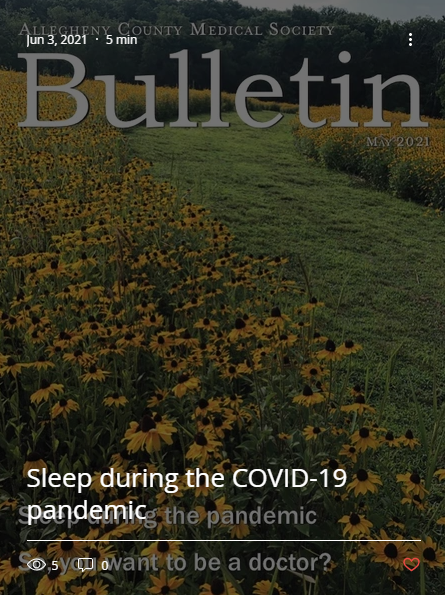
2020 was a long year, and the pandemic is not over yet. On the bright side, we can learn a lot from what has happened. Even early on in this experience, sleep researchers were busy evaluating the effects on our sleep with new studies, or altering ongoing studies to see the effect that this disruption of our daily routine has had on our sleep. The annual Sleep Medicine conference that is held in June was postponed to August to allow time to adjust to the virtual platform. Even by then, there was a wealth of information starting to emerge.
Rebecca Robillard, PhD, reviewed her survey of 5,525 Canadian participants aged 16-95, who reported sleep difficulties that increased from 36% before the outbreak to 51% after the outbreak, although approximately 6% of people reported sleeping better. The only significant factor that emerged was a 28-minute delay in wake-up time. There were three subgroups: 1) those with extended time in bed (TIB), 2) those with reduced TIB and 3) those with a Phase Delay (going to bed later, getting up later and a slightly increased TIB). The latter two subgroups were seen more often in women, evening chronotypes (“night owls”) and those with increased anxiety and depression. This emphasizes the need for tailored sleep interventions based on the distinct profile of the particular sleep problem.
Genevieve Forest, PhD, reviewed sleep patterns that youth demonstrated by her survey of 588 participants aged 12-25. Before the COVID-19 pandemic, the difference between weekday and weekend bedtimes was 1 hour 14 minutes, but after the pandemic began there was only a 35-minute difference. Most notably, the wake-up time difference on weekdays vs. weekends was 2 hours 3 minutes before and only 17 minutes after the pandemic began. The bedtime difference was greatest for younger children, ages 12-14. Sleepiness improved for younger teens; ages 12-17. Sleep quality improved for 15-17 years old. However, those age 22-25 had more sleep difficulties. Nocturnal awakenings, early morning awakenings and nightmares increased in those aged 18-25.
Charles Morin, PhD, discussed his findings that were revealed in an ongoing longitudinal study of the natural history of insomnia in which the cohort of 1,434 adults had been studied for 10 years. A survey was given during one peak of the COVID-19 crisis, in May 2020, and 611 responded. The average age of participants was 47 years old and 64% were female. The incidence rate of new onset insomnia (32%) and persistence rate (76%) were much higher than the natural history of insomnia findings in the cohort at their 10-year follow up in 2018. The factors associated with this were increased anxiety, poor sleep quality, increased depression, more fatigue, increased phase delay, increased TIB and decreased sleep efficiency.
The effect on dreams was presented by Elizabeth Solomonova, PhD, in which a Typical Dream Questionnaire was given via an online survey to 968 participants aged 12-92 covering 60 specific items and asking about the presence and frequency in the last seven days regarding topics of the pandemic, human threat, nature threat, death, inefficacy and paranormal subjects. Sixty-two percent dreamt about being inefficient, 42% dreamt of human threat, 39% about the pandemic and 39% about death, suggesting that dreams react to stressors in metaphoric and associative ways rather than in a direct and concrete manner. The studies on the effect of the COVID-19 pandemic on health care workers was just beginning, and we will be seeing this effect for a long time. Across five early studies, 39% of health care workers reported insomnia. Stress, anxiety and depression were common exacerbating factors as would be expected.
So, what is the solution? Stress is a part of life. Pandemics are not frequent occurrences, but some virologists warn that there may be more in the not-so-distant future.
There were sleep benefits for some in the population. With the elimination of travel time to and from work or school, some sleep improved because one’s time for sleep improved. This was most evident in the survey of youth sleep with the ability to sleep in later, more consistent with their natural and weekend sleep schedule, and therefore resulting in less daytime sleepiness and improved sleep quality. To be able to sleep on a consistent schedule that is more in tune with one’s circadian rhythm results in better sleep. Timing is everything! But of course, too much of a good thing is not good for anyone. Like “Goldilocks”– not too little and not too much TIB, seven to nine hours is “just right” for most adults.
For many people, the lack of a consistent daily routine and having no place to go led to extended TIB, which leads to decreased sleep efficiency (unless you’re sleep deprived) and therefore insomnia. You can even produce this in good sleepers. Getting up around the same time every day no matter how much you have slept is a good way to strengthen your circadian rhythm and avoid many pitfalls that lead to poor sleep.
The pandemic also closed gyms, and, in some instances, people were even afraid of going outside. Exercise classes stopped. In essence, much of the way that we exercise came to a halt. Even just 20-30 minutes of exercise per day can be vital to consolidating and deepening sleep. Consistency is most important and timing such that it is done in the day (morning, afternoon, or early evening) but not within three hours of going to bed because it raises core body temperature. Core body temperature must fall and stay down for one to fall asleep and stay asleep.
Most magazines will list the “10 secrets to getting a good night’s sleep” … time for winding down, turning off the computer, no bright lights, no late-night alcohol or heavy meals, do not exercise close to bedtime, white noise machines, pillow or mattress choices … but the most important of these is temperature. The National Sleep Foundation has recommended 60-67 degrees as the optimal temperature for sleeping. I cannot overemphasize this. Physiologically, we fall asleep as our body temperature drops, and we stay asleep as long as our temperature stays low. We wake when our temperature rises. This is linked to our circadian clock (timing), but it is affected by ambient temperature. So, of all the suggested good sleep habits, the three most important are what I have coined in my practice and in my books as “The Three Ts to get your Zzzzzz – Timing, Temperature and the Track” (i.e., exercise). Sweet dreams!
Dr. Sunseri, associate editor of the ACMS Bulletin, is a diplomate of the American Board of Neurology and Psychiatry, American Board of Sleep Medicine and American Board of Clinical Neurophysiology, and a diplomate, ABPN, Subspecialty in Clinical Neurophysiology and ABMS, Subspecialty in Sleep Medicine. She can be reached at [email protected].

